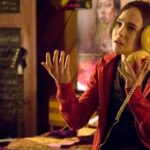The Goosebumps books have been scaring generations of young readers silly for 30 years now. But franchise mastermind R.L. Stine tells Yahoo Entertainment that he’s no ‘fraidy cat. “Here’s the strange thing about me — I don’t get scared” the 78-year-old author confesses. “I think there’s something missing in my brain! Even as a kid, horror always makes me laugh. Whether I’m reading a Stephen King book or going to a scary movie, I’m the one in the audience that’s laughing.”
That’s typically not the case for your average kid picking up their first Goosebumps book. What started in 1992 as an experiment in bringing horror to tweenage bookworms has become a cross-media phenomenon that includes TV shows, movies, comic books and video games. And if Stine had had his way three decades ago, the series would have ended before it even began.
“I didn’t want to do Goosebumps,” he reveals now, crediting his wife — author and editor Jane Waldhorn — with pushing him to confront the one thing he actually was afraid of: writing for a younger audience. “She kept after me, saying, ‘No one’s ever done a horror series for 7- to 12-year-olds. We have to try it!’ I said, ‘All right, we’ll try two or three of them.'”
Needless to say, Stine wound up writing a lot more than two or three Goosebumps installments. Between all the spin-offs and ancillary material, there are more than 200 books in the franchise, which boasts more than 400 million copies sold over the past three decades. Stine’s latest book, Haunting With the Stars, is in bookstores now, with the next one, Slappy, Beware! — starring the franchise’s mannequin mascot — scheduled to arrive in September. “That’s the kind of businessman I am,” he jokes. “I didn’t want to do Goosebumps and now it’s 30 years later. Can you believe that?”
In a spirited conversation, Stine reveals the Goosebumps installment he thought was too scary for the series, why he has a love/hate relationship with Slappy, and which Stephen King book he’s stolen multiple plots from.
I started reading YA horror books in the ’80s before Goosebumps came along. I especially enjoyed stuff like your book The Babysitter or Christopher Pike’s Remember Me, which were all about teenagers that were older than me at the time.
Yeah, we always aimed those books at 10- or 12-year-olds, because they liked to read about people who were older than themselves. And there were slightly naughty, too! We’d always go up a few years no matter, but in general we found that kids were between 10 and 12 when they started reading the teen stuff. I get to scare a lot of generations: when I do book signings now, I get 7-year-olds and I get 40-year-olds! [Laughs]
I understand that when you were a kid, you read stuff like the classic Tales From the Crypt comics.
Yes, those were very big influences. I loved the artwork, and the stories were gruesome, but funny at the same time. They all had funny twist endings, which is something that I do, too.
You lived through that period in the ’50s after Frederick Wertham published Seduction of the Innocent and all those comics were censored or went away entirely. Did you miss them when they were gone?
I was a kid, so I wasn’t aware of the larger things that were happening. I just realized that they were suddenly gone and the comic books that were there weren’t as gory. They still had science fiction and suspense comics, but they weren’t as good as the horror ones. So I went on to discover actual books: I grew up in Columbus, Ohio, and one day my mother dropped me off at the little library on Main Street. The librarian was waiting for me, and she knew I liked comic books. She said: “I have something else I think you will like,” and she took me to a shelf of Ray Bradbury stories. They were so great: beautifully written and magical and all of them had great twist endings. That was what really turned me into a reader.
Bradbury was huge for me, too, when I was young. “The Veldt” is one of my favorite short stories — also, “The Small Assassin.”
Oh yeah. I liked his non-science fiction stuff, too, like Dandelion Wine. That book is poetry — just beautiful.
Speaking of censorship, there’s a been a recent push in some parts of the country to ban certain books. Is that something that has you concerned?
Well, of course, I’m against it. I haven’t run into that trouble with Goosebumps or anything, but it’s a terrible thing.
Your first Goosebumps book was Welcome to Dead House in 1992. What were the lessons you learned from that story that you were able to apply going forward?
I actually thought that book was too scary for the series. It didn’t have the balance of humor and scariness, and I corrected that in the second book, Stay Out of the Basement. When scenes started to get really intense in that book, I made sure to put in something funny. And that’s what I stuck to from then on. There are a couple books that stand out as being scarier than others, but mostly I think they are the right balance.
You mentioned that you always include a twist ending: what is it about that device that thrills kids so much?
Well, it’s teasing, you know? Kids like to be teased and they like to be surprised. So what I try to do is have one major twist somewhere in the middle of the book where kids will say: “Oh my goodness, I had no idea that’s what was going on!” Something that just shocks them and turns the story around. That’s part of the appeal of Goosebumps: these aren’t stories that go in a straight line — there are all kinds of twists and surprises.
One thing I do as a writer is that I come up with the ending first so that I can keep readers from guessing it. I do a complete outline of every book, but I always try to get the ending before I write Chapter One. Because then I know how to fool the reader. Rod Serling and Agatha Christie were huge influences that way. I can’t tell you how many Agatha Christie plots I’ve stolen! I think Stephen King’s scariest book is Pet Sematary, and I’ve stolen that premise for or five times. [Laughs]
I’m sure you’ve met King — did you tell him that?
Oh yeah, I told him! I’ve only met him once, and we had a nice talk. He accused me of taking every amusement park plot and not saving them for anyone else! [Laughs]
Well, he did write Joyland so he eventually got there!
Yeah, he wrote one! I remember that I also said to him: “Stephen, a magazine once called me a literary training bra for you,” which is true! And he said, “Yes, I know.” I’m Stephen King for kids.
The invention of Slappy in 1993’s Night of the Living Dummy was clearly a pivot point in the series. Did you realize how important he’d become to Goosebumps?
I had no idea! I think he became more central because of the Goosebumps movies. People really liked him in the movies. But I never really planned for him to be anything. I don’t really get Slappy! I don’t know why people think he’s so scary. I like writing him because he’s like an insult comic — he’s so nasty to everyone. So I love writing that stuff. But now it’s in my contract that every other book has to be about Slappy. Believe me, it’s not getting any easier to come up with plots about a dummy who comes to life. [Laughs]
Arthur Conan Doyle came to resent Sherlock Holmes — would you say you resent Slappy?
I actually killed him in one book, and wrote about the ghost of Slappy! [Laughs] But like Doyle, I had to bring him back. I wish I had invented more good villains so I wouldn’t have to write about him constantly. But it’s fine!
You’ve got to give the audience what they want.
Yeah, that’s all I do. [Laughs]
[embedded content]
The Goosebumps TV series was iconic for ’90s kids. Did that help raise the franchise’s profile?
Listen — nothing sells books better than television! When the series premiered in 1995, the book sales went up by about a million a month. It was a huge jump because of the show. People say that kids watching television is terrible, but it also encourages them to read. When the show started, the idea was to just adapt the books, but I was writing a Goosebumps book a month at that time, so I couldn’t spend a lot of time on the TV series. It was fun to see other writers taking one of my books and going off in their own direction with it. The Haunted Mask episode was very good, and so was A Night in Terror Tower.
There were also some future famous faces who got their start on the show — Ryan Gosling, Hayden Christensen and Scott Speedman all appeared on Goosebumps.
It was a Canadian show, and we used every kid in Canada! I’d be at book signings in America, and kids would ask: “How do I get to be on the Goosebumps show?” And I’d say: “Well, you have to be Canadian.” [Laughs]
There’s a reboot in the works for Disney+ — are you happy that it’s coming back to TV?
Oh yeah. It’ll keep the book series going! I’m not really in the loop on the TV show, but my understanding is that it’s not going to be an anthology series, it’s going to be a continuing story. But honestly, I haven’t heard any more about it than that.
How about the Goosebumps movies? Are there more coming?
There’s still talk about more Goosebumps movies, and I also hear rumors about more Fear Street movies for Netflix, because the first ones did so well last summer. Those films kind of shocked me, because they were all R-rated, and I’ve never done anything R-rated! All those teenagers were getting slashed. I was like, “Suddenly, I have a slasher movie!”
[embedded content]
Did the films impact the way you approached the books at all?
That’s a good question. Well, they gave Slappy more power than I had ever given him. Like in the second film, they had him bringing all these things to life, which I’d never done before. So suddenly I could give Slappy more powers in the books! I got lucky with the movies in that they were actually good, and they didn’t have to be. A lot of kids’ movies are horrible, and I also didn’t have much input into them at all. But I’m very proud of both movies. They’re really funny, and Jack Black is terrific. There’s a line he says in the first Goosebumps movie that’s just perfect: “Every story has a beginning, a middle and a twist.” I love that line. I wish I’d written it! [Laughs]
The Goosebumps series are available at all major booksellers, including Amazon.




